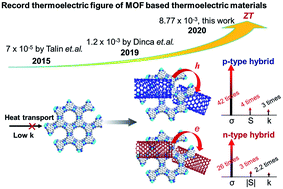Enhanced electrical properties and restrained thermal transport in p- and n-type thermoelectric metal–organic framework hybrids†
Abstract
Making organic devices with a single material is very challenging although single material devices have been considered as the next generation device for organic electronics. Here we report an effective approach to improve the thermoelectric (TE) performance of p- and n-type metal–organic framework (MOF) based hybrids. The polarity of the mixed-carrier hybrids was demonstrated to be determined by the component with a higher carrier concentration. A selective increase in the three key TE parameters was observed, leading to a dramatic enhancement in ZT. The maximum ZT value was boosted up to ∼270 times compared with the ZT of a pristine MOF , which is over 7 times higher than the previously reported ZT record for MOFs. Charge transport mechanism analysis reveals that a parallel transport model fits well with the change of the three TE parameters as a function of the CNT fillers. An all-MOF device was fabricated to show the energy conversion performance of this single-material TE device. Selective improvement in electrical properties and restraint in thermal conductivity present an efficient approach of developing MOF based TE materials. The study of the mixed carrier in a hybrid may lay a foundation for developing single-material organic electronics for various applications such as single material solar cells.



 Please wait while we load your content...
Please wait while we load your content...